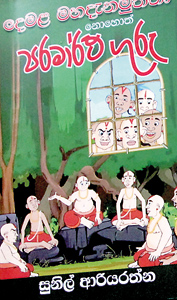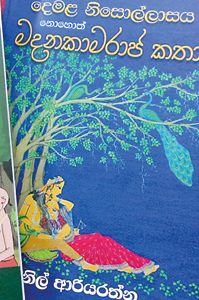Insight into the life of Mahadenamutta
Mahadenamutta, ‘the Wise Man’ has been a well-known character in our folklore for a very long time. The stories revolving round Mahadenamutta and his ‘golayas’ are still being related, so popular are they among both children and adults.
Prolific writer, Professor Sunil Ariyaratne now introduces us to ‘Paramartha Guru’ – the Tamil Mahadenamutta.

“Mahadenamutta was born in Tamil Nadu. His name in the birth certificate is Paramartha Guru. The father is an Italian Catholic priest named Constantius Joseph Beschi. Paramartha Guru could speak several languages. In South India he spoke Tamil, Telugu, Kannadi and other languages and spoke Latin, English and French when he went to the West.
He was brought to Sri Lanka by some Catholic priests around the 18th century. He stayed for a while in Colombo and then started roaming around the countryside. He started talking in Sinhala. He was a fat bellied Brahmin.
He went to our villages wearing cloth and coat with a comb on the head chewing betel. The birth certificate with his name as Paramartha Guru was burnt and he became popular among the villagers as Mahadenamutta. Now he is our man.” This is how Prof. Ariyaratne describes his antecedents.
He introduces his book as “ Constantius Joseph Beschi’sParamartta Kuruvin Katai (The First Burlesque in Tamil Prose) in Sinhala”. He started searching for the Tamil book after reading a reference in a 17-page article titled ‘The Mahadenamutta Stories’ in Bishop Edmund Peiris’ ‘Studies Historical and Cultural’ published in 1978 and wanted to introduce the Tamil Mahadenamutta to Sinhala readers.
According to Bishop Peiris, all the stories about Mahadenamutta are Tamil stories from Tamil Nadu. They are either translations or adaptations of what appeared in Joseph Beschi’s book, which was referred to as “a burlesque, the first of its kind in Tamil prose”, “humorous fable” and “entertaining fable”. Beschi was considered “the father of Tamil prose fiction”.
The Tamil book refers to Paramartha Guru and his five pupils. The teacher is a foolish man. So are the pupils. Their names are Madaiyyan (Blockhead), Matti (Idiot), Murkkhan (Simpleton), Mudan (Dunce) and Pedai alias Milechchan (Fool). The teacher’s name appears a ‘Gooroo Noodle’ in an English translation by B. Babington. The book contains escapades of the party during their numerous journeys.
They face many an obstacle during their outings. The teacher gives foolish solutions that lead to further mishaps. These provide the humour. It is assumed that Beschio tried to ridicule the 18th century Hindu religious hierarchy and the people who blindly accepted what they preached, Prof. Ariyaratne says.
Glancing through the Sinhala translations of the stories repeated in the book, most of the popular tales about Mahadenanamutta are included.
Tamilian Nights
Prof. Ariyaratne has also released a Sinhala version of “Tamil Nights Entertainments or Madana Kama Raja Katha’(‘Demala Nisollaasayahevath Madanakamaraja Katha’), a publication released in 1855. His intention is to let the Sinhala reading public get at least a broad idea of Tamil literature.

An English translation had been published in 1886 titled ‘The Dravidian Nights Entertainments – Being a translation of Madamakamarajan kadai’.
The title has obviously been copied from the popular ‘Arabian Nights Entertainments’ so he was influenced by this title to call it a ‘Demala Nisollaasaya’.
The Sinhala word ‘Nisollasaya’ had first been used by writer Albert de Silva who translated ‘Arabian Nights’ in 1894. Incidentally ‘nisa’ means ‘night’ and ‘ullasa’ ‘joy’.
Prior to presenting 15 tales, Prof. Ariyaratne presents a comprehensive essay on what the tales are. They had first been related by story tellers orally.
The two books are yet another research effort by Prof. Sunil Ariyaratne whose work deserves a separate study. It’s heartening to note that there are at least one or two university dons who believe in research.
comments powered by Disqus

